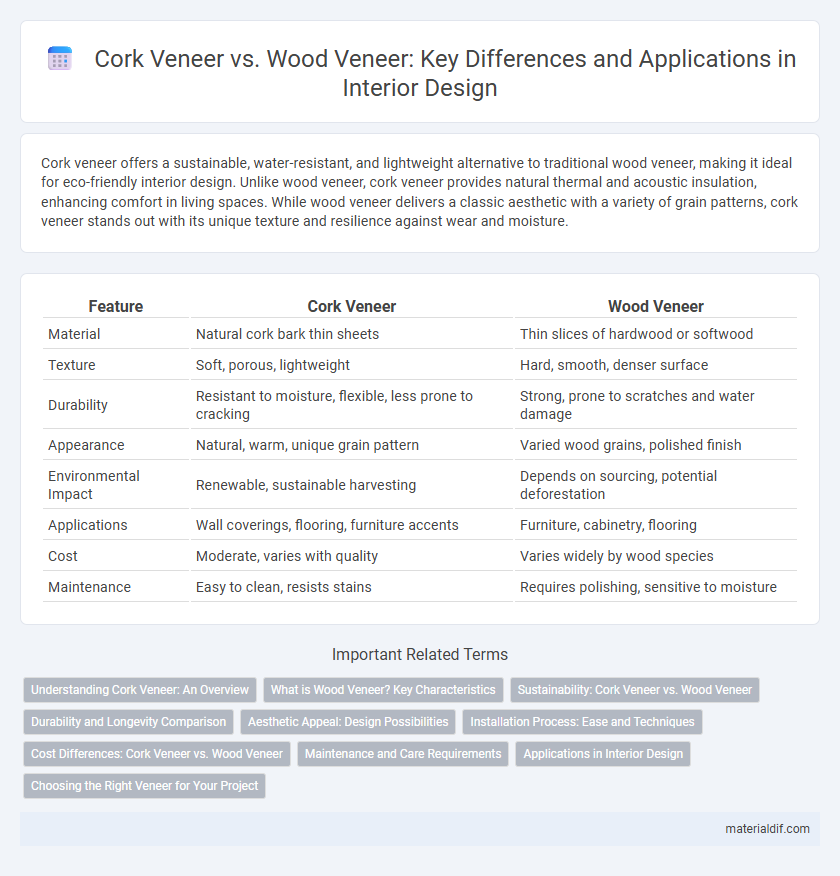Cork veneer offers a sustainable, water-resistant, and lightweight alternative to traditional wood veneer, making it ideal for eco-friendly interior design. Unlike wood veneer, cork veneer provides natural thermal and acoustic insulation, enhancing comfort in living spaces. While wood veneer delivers a classic aesthetic with a variety of grain patterns, cork veneer stands out with its unique texture and resilience against wear and moisture.
Table of Comparison
| Feature | Cork Veneer | Wood Veneer |
|---|---|---|
| Material | Natural cork bark thin sheets | Thin slices of hardwood or softwood |
| Texture | Soft, porous, lightweight | Hard, smooth, denser surface |
| Durability | Resistant to moisture, flexible, less prone to cracking | Strong, prone to scratches and water damage |
| Appearance | Natural, warm, unique grain pattern | Varied wood grains, polished finish |
| Environmental Impact | Renewable, sustainable harvesting | Depends on sourcing, potential deforestation |
| Applications | Wall coverings, flooring, furniture accents | Furniture, cabinetry, flooring |
| Cost | Moderate, varies with quality | Varies widely by wood species |
| Maintenance | Easy to clean, resists stains | Requires polishing, sensitive to moisture |
Understanding Cork Veneer: An Overview
Cork veneer, derived from the bark of the Cork Oak tree, offers a sustainable and lightweight alternative to traditional wood veneer, known for its natural elasticity and thermal insulation properties. Unlike wood veneer, cork veneer resists moisture and mold, making it ideal for environments with fluctuating humidity. This eco-friendly material also provides sound absorption benefits while maintaining a unique textured appearance distinct from conventional wood veneers.
What is Wood Veneer? Key Characteristics
Wood veneer is a thin layer of natural wood sliced from logs, prized for its authentic grain patterns and textures. Key characteristics include its flexibility, sustainability, and ability to enhance furniture and surfaces with genuine wood appearance while minimizing the use of solid wood. Unlike cork veneer, wood veneer offers a diverse range of wood species and finishes, making it a versatile choice for interior design in Cork.
Sustainability: Cork Veneer vs. Wood Veneer
Cork veneer, harvested from the bark of cork oak trees without harming the tree, offers a renewable and eco-friendly alternative to traditional wood veneer, which often involves deforestation. Cork's natural ability to regenerate its bark every 9-12 years ensures a sustainable lifecycle, significantly reducing environmental impact. Wood veneer production typically requires cutting down hardwood trees, leading to habitat loss and higher carbon emissions compared to the low-impact cork harvesting process.
Durability and Longevity Comparison
Cork veneer offers exceptional durability due to its natural resistance to moisture, mold, and wear, making it ideal for high-traffic areas and humid environments. Wood veneer, while aesthetically versatile, is more prone to scratches, warping, and damage from prolonged exposure to moisture. Over time, cork veneers typically maintain their structural integrity and appearance longer than wood veneers, providing a sustainable, long-lasting surface option.
Aesthetic Appeal: Design Possibilities
Cork veneer offers a unique, natural texture with warm, earthy tones that create a distinct aesthetic appeal, making it ideal for eco-friendly and contemporary designs. Wood veneer provides a broader palette of grains and finishes, enabling versatile styling from classic to modern interiors. Both materials enhance design possibilities, but cork veneer stands out for its tactile, sustainable charm, while wood veneer excels in traditional elegance and variety.
Installation Process: Ease and Techniques
Cork veneer offers a lighter, more flexible installation process compared to traditional wood veneer, making it suitable for DIY projects and irregular surfaces. Its adhesive backing simplifies application, eliminating the need for complex tools or extensive preparation typically required for wood veneers. Wood veneer installation often demands specialized glues, clamps, and precise moisture control to avoid warping, which can extend time and complexity.
Cost Differences: Cork Veneer vs. Wood Veneer
Cork veneer generally costs less than wood veneer due to the sustainable harvesting process and faster renewal rate of cork oak bark, making it an economical choice for eco-conscious projects. Wood veneer prices vary widely based on species, with exotic hardwoods like mahogany or walnut commanding higher prices compared to common woods, contributing to a significant cost differential versus cork veneer. Maintenance costs also tend to be lower for cork veneer, as its natural resilience to moisture and wear reduces the need for frequent refinishing or repairs.
Maintenance and Care Requirements
Cork veneer requires minimal maintenance due to its natural resistance to moisture, mold, and mildew, making it ideal for humid environments. Wood veneer, while offering a more traditional look, demands regular polishing and protection from scratches and water damage to preserve its appearance. Both materials benefit from gentle cleaning with a damp cloth and avoiding harsh chemicals to extend their lifespan.
Applications in Interior Design
Cork veneer offers exceptional sustainability and flexibility, making it ideal for eco-friendly interior design applications such as wall coverings, furniture panels, and decorative accents. Its natural insulation properties and sound absorption enhance comfort in residential and commercial spaces, distinguishing it from traditional wood veneer. Wood veneer remains preferred for its classic grain patterns and durability in cabinetry, flooring, and high-end furniture, but cork veneer is increasingly favored for modern, sustainable design solutions.
Choosing the Right Veneer for Your Project
Choosing the right veneer for your project depends on factors like durability, aesthetics, and environmental impact. Cork veneer offers a lightweight, eco-friendly option with natural insulation properties, ideal for sustainable designs and soundproofing, while wood veneer provides a classic, versatile look with a wider range of grain patterns and finishes suitable for traditional woodworking. Assess the project's functional needs and style preferences to determine whether cork's renewable advantages or wood's rich textures better align with your goals.
Cork Veneer vs Wood Veneer Infographic

 materialdif.com
materialdif.com